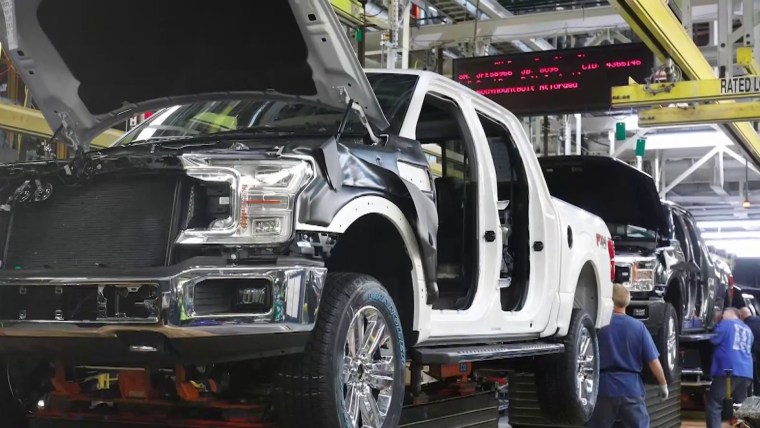Electric vehicles got a big boost earlier this month when the Colonial Pipeline, which delivers 45 percent of fuel to the Eastern Seaboard, was shut down by a ransomware attack. The crisis resulted in “dangerous levels of smugness in Tesla owners,” as late night host Seth Meyers suggested. But EV drivers shouldn’t be quite so self-satisfied, experts say.
“The hacking of the Colonial Pipeline is one example of the vulnerability of our…infrastructure,” said Susan Bell, Director – Americas Refining & Marketing, IHS Markit. But the broader energy network — including the electric grid — is vulnerable to both digital attacks and physical issues, she added, with potentially “devastating results.”
As part of his push for electrification, President Joe Biden is scheduled to visit Ford’s new Rouge Electric Vehicle Center on Tuesday, a facility that will begin producing the Lightning, an all-electric version of the automaker’s full-size F-150 pickup.
Biden is making electric vehicles a cornerstone of his environmental program, with $174 billion of the administration’s proposed infrastructure plan devoted to EV incentives and the creation of a nationwide network of 500,000 charging stations.
It’s been more than four decades since the U.S. was struck by a pair of Mideast oil embargoes. While the country is today less dependent upon foreign oil supplies, a series of problems have cropped up in recent months to show that motorists still face the risk that gas supplies can be disrupted. There have been refinery problems, pipeline issues and even a shortage of tank truck drivers to get fuel to the pump.
To EV proponents, these are all the more reason why the U.S. should accelerate the switch from the internal combustion engine to electric drive technology.
“If you drive an electric car, this would not be affecting you,” U.S. Energy Secretary Jennifer Granholm said during a White House news conference last week, referencing the Colonial hack.
But the nation’s electric grid is far from secure itself. The ice storm in Texas left some parts of the states in the dark for over a week. California utilities have been forced to disrupt power on several occasions due to storms or to prevent equipment from setting wildfires. The state also faced rolling blackouts a few years back due to energy supply shortages.
Much of the electric grid has been in place since the 1950s and 1960s, according to industry data, with some sections actually dating back to the late 19th century.
The massive SolarWinds cyberattack saw a number of utilities hacked, though none were shut down — whether through luck or careful planning. There hasn’t been a successful cyberattack against bulk power in the last 15 to 20 years, according to American Public Power Association President and CEO Joy Ditto, but that “doesn’t mean it can’t happen.”
While electric utilities are the only infrastructure sector required to meet strict cybersecurity standards, "we don't think they're the end of the story," Ditto said. "We have to be in a kind of a posture of continuous improvement in our sector, given how critical it is."
The ongoing shift to battery-electric vehicles will test the reliability of America’s electric infrastructure as never before, experts believe. Until recently, plug-based models were relative rarities. But new models like the GMC Hummer pickup and the Lucid Air will take to the nation’s highways by early next year, with dozens more set to follow.
Estimates vary substantially, but some research groups, including J.D. Power and IHS Markit, believe 30 percent of the new vehicles sold in the U.S. by 2030 could be electric.
How much of an impact this will have is a matter of intense debate.
“The transition to electric drive will be a decades-long approach and, therefore, the transition of grid behavior will be slow,” said Pat Romano, CEO of ChargePoint, one of the nation’s largest charging companies. “As long as the charging of vehicles day to day is managed, this can be modulated against the grid load that already exists.”
One reason for Romano’s optimism is his expectation that 80 percent of EV owners will charge their vehicles at night, and mostly from home, taking advantage of a general surplus of off-peak generating capacity. Many utilities have tried to encourage this behavior by offering customers significant night time discounts on energy.
The Department of Energy estimated that demand for electricity — much of that from electric vehicles — could rise by 38 percent by 2050.
But not everyone is so optimistic. As EV adoption grows, there could be millions with no access to home chargers and thus dependent on using public charging during the day. A 2019 study by the Department of Energy estimated that demand for electricity — much of that for electric vehicles — could rise by 38 percent by 2050.
That surge could happen even more quickly in some parts of the country, such as California and Washington, where EV sales have been growing fastest. Seattle, for example, hopes to have a full third of its drivers motoring around in electric vehicles by the end of this decade.
"electric" - Google News
May 18, 2021 at 11:47PM
https://ift.tt/2RsU87d
Electric vehicles escaped last week's gas shortage — but the next cyberattack could take them down instead - NBC News
"electric" - Google News
https://ift.tt/2yk35WT
https://ift.tt/2YsSbsy
Bagikan Berita Ini

















0 Response to "Electric vehicles escaped last week's gas shortage — but the next cyberattack could take them down instead - NBC News"
Post a Comment